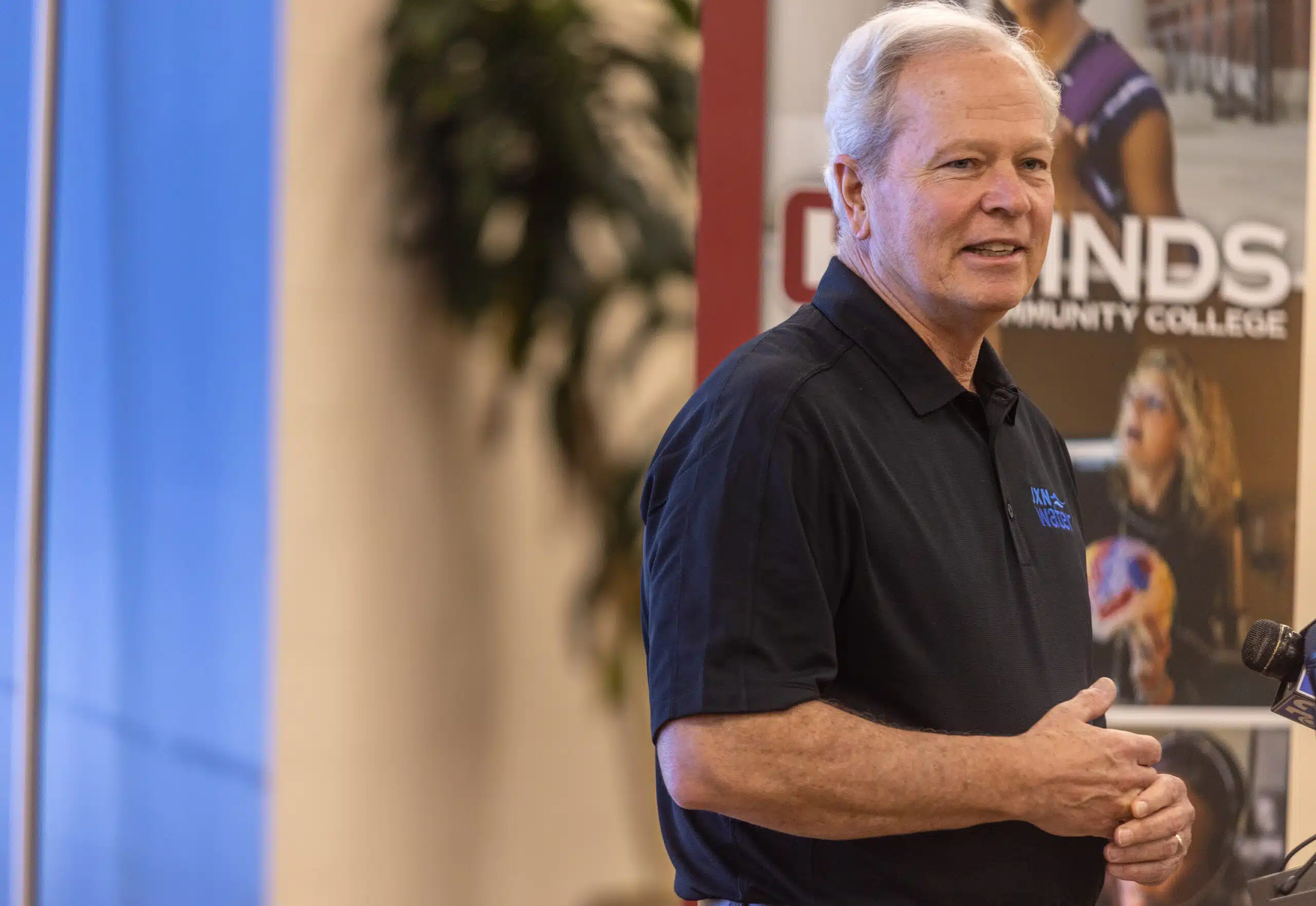Mississippi Today
Jackson leaders insist city water is safe to drink. Some mothers struggle to trust them.

As federal and city officials continue to work to assure residents the water flowing from the troubled Jackson system is safe to drink, distrust among many capital city residents — particularly mothers and caregivers of small children — runs deep.
Regular boil water notices, lack of consistent water pressure and concerns about the safety of drinking the water even when there is not an active boil water notice are commonplace in Mississippi’s largest city.
Multiple federal lawsuits about the city’s recent water quality are pending, and the U.S. Department of Justice last fall acknowledged several major water system problems, including an acknowledgment that the city had consistently not met federal safe water standards. And since 2016, the city has mailed residents quarterly warnings that pregnant women and small children, who are most susceptible to lead poisoning, should follow state and federal safety guidelines before drinking the water.
In recent days, Ted Henifin, the federal appointee to manage the city’s water system, argued that those city notices are no longer necessary after years of clean water tests. Jackson Mayor Chokwe Antar Lumumba has for months publicly repeated the refrain that the water is safe to drink.
In mid-June, while reiterating the water is safe to drink, Lumumba joined officials at the Jackson-Hinds Comprehensive Health Center to publicly announce a $100,000 donation to provide water filters specifically for pregnant women and with children under the age of 5.
Meanwhile, many caregivers across the city struggle to trust that the water flowing from the pipes is safe to give their loved ones.
“It’s hard in every way,” said Mary Rooks, a mother of four children under 10, who runs “JXN Motherhood,” an Instagram account that connects mothers across the capital city. “There are so many costs when your children are young … We pay a water bill, so you wouldn’t think you’d have to add an additional cost with water … There are so many factors of mom guilt. You just want to be the best parent of your child — bathing is a pretty simple necessity, and you’re like, ‘Can I bathe them in this water?’”
Rooks says that other parents, including parents of newborns, reached out to her during and after the 2022 Jackson water crisis, which left residents without safe tap water for weeks, to ask about how to handle various water concerns — many of which would likely not even occur to non-parents.
Even after the city-wide crisis passed, a friend with a newborn texted Rooks to ask if it was safe to wash baby bottles in the city’s water. She told them that she thought it should be fine, but the question was indicative of larger struggles parents of young children and babies have faced and continue to face.
“It’s nuts, all the implications that it has,” she said. “Anyone without children wouldn’t have a category for (the difficulties), which is fine — they haven’t been there. But washing bottles is taxing in and of itself, and then add I’m washing bottles with bottled water? It’s ridiculous.
“There’s a lot of responsibilities and hardships of parenthood, and then such a simple thing of water added to that makes it so much more complicated,” Rooks continued. “We pay for water, so it’s like one of those things where we feel like it’s a right as a citizen to have access to clean water, not only for ourselves, but for our families … It’s a simple thing, but when it’s taken away it’s a huge stress added on top of all the million ways you question yourself as a parent.”
‘The baby is extraordinarily susceptible’
During the August 2022 water crisis, some parents used unique methods to ensure their children had safe water to bathe in.
Maisie Brown started the MS Student Water Crisis Advocacy Team with more than 20 other students at Jackson State University, where she is now a rising senior. The organization — organized almost immediately after Gov. Tate Reeves announced that the city would be without clean, running water “indefinitely” — delivered bottled water to people’s homes.
Though Brown says that the majority of the calls she received were from elderly and/or disabled people, she estimates that roughly 30% of the calls were from mothers of young children. These mothers were hesitant to use the water for bathing or making formula for their babies, even after boiling it.
“You don’t want to put your baby in some water that might have bacteria or microbes in it,” Brown said. “(Adults) barely want to wash our hands with it.”
To help parents with bathing small children, some donation-based organizations like the MS Student Water Crisis Advocacy Team, asked people to donate not only bottled water, but also baby wipes and products like shower bags, which would allow people to freshen up without fully immersing themselves in contaminated water.
One week, Brown says her organization got a call from a disabled mother of several young children. When a volunteer arrived, she saw that the home was surrounded with buckets that were full of rainwater. The mother had been collecting the rainwater and, after boiling it, used it to bathe her children and flush toilets. She was more comfortable using boiled rainwater than she was using boiled water out of the faucet.

This mother’s continued concerns are not unique, as some parents fear that contaminants in the tap water will be absorbed through their child’s skin.
Dr. Christina Glick is a neonatologist who runs Mississippi Lactation Services, a free-standing breast-feeding clinic in Jackson. She estimates that about 70% to 80% of her clients live in the capital city. Glick says that breastfeeding is “the greatest protection against a crisis like this.”
The people who would be most negatively affected by drinking contaminated water are immunocompromised people and newborn babies. Even if a mother were to get sick from drinking the water herself, Glick says that breastfeeding filters the majority of contaminants out of the milk that babies drink.
Her major concern is for mothers who use formula to feed their babies.
“If the water isn’t clean, the baby is extraordinarily susceptible to even very small amounts of contaminants. It could make them very sick,” she said.
Globally, diarrhea is the second leading cause of death for children under the age of 5. According to the CDC, “about 88% of diarrhea-associated deaths are due to unsafe water, inadequate sanitation and insufficient hygiene.”
Despite breastfeeding being the safest option for those who are still concerned about the cleanliness of the water, it is not without issue, nor is it feasible for all parents and caregivers.
The water is ‘yucky’
Nakeitra Burse, owner of Six Dimensions, a public health research, development and practice agency, said that her major concerns with the water crises are how they impact breastfeeding mothers and people who are expecting.
Burse says that not having adequate access to clean, drinkable water could impact mothers’ milk supply. Dehydration can lead to reduced milk supply and to serious pregnancy complications. Water is essential for life at all stages, but it is especially vital when developing a new life, she said.
“For pregnant or postpartum mothers, (water) is really, really important to them being able to provide for their families, provide for their babies, provide for themselves and do whatever they need to produce the milk they need,” she said.
Because babies have such sensitive skin, Burse says she understands parents’ hesitation to use contaminated water for bathing. Not knowing what’s in the water could potentially have long term impacts for infants, she said.
Laurie Bertram Roberts is the executive director and co-founder of the Mississippi Reproductive Freedom Fund. She is also a mother, grandmother and Jacksonian. Her granddaughter, who is a toddler, has never taken a bath in the capital city’s water. She and her family filter her granddaughter’s bathing water through a device that removes lead.
Bertram Roberts says that many of the expectant people with whom she works are already hesitant to use the water in any capacity because “the water looks gross, it smells gross and who the heck wants to put that in their body when they’re carrying a baby to term?”
But, she says, concerns go beyond those for expectant people and young children. Caregivers, in general — those who are helping care for elderly or disabled people — also have reasons to be wary of the water, especially if they are dealing with ailments like bed sores that make them more susceptible to infection.
Her own daughters have eczema, a skin condition that affects nearly 20% of African-American people. According to a 2019 study, Black and Hispanic children are more likely to miss school due to eczema. Bertram Roberts says that her daughters are hesitant to bathe using Jackson’s water in fear of exacerbating their eczema.
For Rooks, it was difficult to explain to her children that they should be drinking water, but that not all water was safe to drink. She and her husband explained to the children that the water was “yucky” and not safe for bathing because the children might potentially get the water in their mouths, or drinking, which led to cognitive dissonance when the family traveled out of town.
“My 7-year-old, he was 5 and 6 at the time, he was pretty receptive,” she said. “But he did think it was weird. We were traveling and getting water out of the sink, and he was like, ‘Why can we drink this water, but we can’t drink the water at home?’”
One of her younger children struggled with the water messaging even more.
“He was utterly confused,” she said. ‘Like, ‘You always tell me to drink more water and now you’re telling me not to drink water?’”
‘Compound issues’ pile up
Though the citywide water crisis has ended, concerns about the long term viability of the city’s water, specifically for young children and expectant mothers, continue. MSDH has issued recommendations for such households including running tap water for one to two minutes before drinking or cooking, not using hot tap water for drinking or cooking and using only filtered or bottled water for baby formula.
But Bertram Roberts thinks that many people, including young children and expectant people, are “probably drinking it anyway because the public health messaging in this city has been inadequate.”
“I think about all of these compound issues because people a lot of time look at it from one issue, like it’s just the lead or it’s just bacteria,” Bertram Roberts said. “But it’s all of those risks and then it’s … with the compound issues of medical racism and lack of health care and issues with access to assistance programs and unemployment issues. All of these compound issues that build on top of, like, just this water issue that make it so much more of a risk and a crisis.”
She notes that many people were unaware about the potential for lead in the water until the lawsuit two years ago — despite the fact that MSDH had acknowledged potential lead concerns about five years prior. She’s also concerned that, though all people should be wary of lead exposure, most of the warnings are only for pregnant people or young children.
The CDC notes that “exposure to high levels of lead may cause anemia, weakness, and kidney and brain damage. Very high lead exposure can cause death.”

At a court status conference in June, Henifin, the city’s water system administrator, repeatedly said that the water is safe for everyone, including pregnant mothers and young children. If anything, he said, filters recently provided to pregnant and expecting mothers could make the water less safe if residents don’t change the filters out every four months, which could cause bacteria to build up.
Still, some don’t want to take any chances with their loved ones. Bertram Roberts says that many of the people with whom she works have only been told not to use the water for making formula, but not that their young children should also avoid drinking the water. Even when parents do know to keep their children from drinking the water, she says people should be cognizant of the added costs parents must incur to be able to do so.
“A lot of parents don’t let their kids drink Jackson water, but think of the expense that is to keep up bottled water for a family on SNAP, a big family. It’s expensive to keep up bottled water for thirsty kids,” she said.
Rooks’ family ultimately ended up installing a reverse osmosis device on their kitchen sink. The device is not a solution to ensuring the safety of water from other sources, like bathroom sinks or bathtub spouts, but it does help in making sure the children have access to at least one clean, safe water source. Rooks also recognizes that not everyone can afford to modify their drinking situation.
“Not everybody can do that,” she said. But it is providing comfort to her to know that her children are a bit safer. “Now they can just drink out of this one little spout. We’ve definitely adjusted, but I hate it’s an adjustment that we have to make.”
This article first appeared on Mississippi Today and is republished here under a Creative Commons license.
Mississippi Today
Mississippi prepares for another execution
The Mississippi Supreme Court has set the execution of a man who kidnapped and murdered a 20-year-old community college student in north Mississippi 30 years ago.
Charles Ray Crawford, 59, is set to be executed Oct. 15 at the Mississippi State Penitentiary at Parchman, after multiple requests by the attorney general’s office.
Eight justices joined the majority opinion to set the execution, concluding that Crawford has exhausted all state and federal legal remedies. Mississippi Supreme Court Justice T. Kenneth Griffis Jr. wrote the Friday opinion. Justice David Sullivan did not participate.
However, Kristy Noble with the Mississippi Office of Capital Post-Conviction Counsel released a statement saying it will file another appeal with the U.S. Supreme Court.
“”Mr. Crawford’s inexperienced trial counsel conceded his guilt to the jury — against Mr.
Crawford’s timely and repeated objections,” Noble said in the statement. “Mr. Crawford told his counsel to pursue a not guilty verdict. Counsel did just the opposite, which is precisely what the U.S. Supreme Court says counsel cannot do,” Noble said in the statement.
“A trial like Mr. Crawford’s – one where counsel concedes guilt over his client’s express wishes – is essentially no trial at all.”
Last fall, Crawford’s attorneys asked the court not to set an execution date because he hadn’t exhausted appeal efforts in federal court to challenge a rape conviction that is not tied to his death sentence. In June, the U.S. Supreme Court declined to take up Crawford’s case.
A similar delay occurred a decade ago, when the AG’s office asked the court to reset Crawford’s execution date, but that was denied because efforts to appeal his unrelated rape conviction were still pending.
After each unsuccessful filing, the attorney general’s office asked the Mississippi Supreme Court to set Crawford’s execution date.
On Friday, the court also denied Crawford’s third petition for post-conviction relief and a request for oral argument. It accepted the state’s motion to dismiss the petition. Seven justices concurred and Justice Leslie King concurred in result only. Again, Justice Sullivan did not participate.
Crawford was convicted and sentenced to death in Lafayette County for the 1993 rape and murder of North Mississippi Community College student Kristy Ray.
Days before he was set to go to trial on separate aggravated assault and rape charges, he kidnapped Ray from her parents’ Tippah County home, leaving ransom notes. Crawford took Ray to an abandoned barn where he stabbed her, and his DNA was found on her, indicating he sexually assaulted her, according to court records.
Crawford told police he had blackouts and only remembered parts of the crime, but not killing Ray. Later he admitted “he must of killed her” and led police to Ray’s body, according to court records.
At his 1994 trial he presented an insanity defense, including that he suffered from psychogenic amnesia – periods of time lapse without memory. Medical experts who provided rebuttal testimony said Crawford didn’t have psychogenic amnesia and didn’t show evidence of bipolar illness.
The last person executed in Mississippi was Richard Jordan in June, previously the state’s oldest and longest serving person on death row.
There are 36 people on death row, according to records from the Mississippi Department of Corrections.
Update 9/15/25: This story has been updated to include a response from the Mississippi Office of Capital Post-Conviction Counsel
This article first appeared on Mississippi Today and is republished here under a Creative Commons Attribution-NoDerivatives 4.0 International License.
The post Mississippi prepares for another execution appeared first on mississippitoday.org
Note: The following A.I. based commentary is not part of the original article, reproduced above, but is offered in the hopes that it will promote greater media literacy and critical thinking, by making any potential bias more visible to the reader –Staff Editor.
Political Bias Rating: Centrist
The article presents a factual and balanced account of the legal proceedings surrounding a scheduled execution in Mississippi. It includes perspectives from both the state’s attorney general’s office and the defense counsel, without using emotionally charged language or advocating for a particular political stance. The focus on legal details and court decisions reflects a neutral, informative approach typical of centrist reporting.
Mississippi Today
Presidents are taking longer to declare major natural disasters. For some, the wait is agonizing
TYLERTOWN — As an ominous storm approached Buddy Anthony’s one-story brick home, he took shelter in his new Ford F-250 pickup parked under a nearby carport.
Seconds later, a tornado tore apart Anthony’s home and damaged the truck while lifting it partly in the air. Anthony emerged unhurt. But he had to replace his vehicle with a used truck that became his home while waiting for President Donald Trump to issue a major disaster declaration so that federal money would be freed for individuals reeling from loss. That took weeks.
“You wake up in the truck and look out the windshield and see nothing. That’s hard. That’s hard to swallow,” Anthony said.
Disaster survivors are having to wait longer to get aid from the federal government, according to a new Associated Press analysis of decades of data. On average, it took less than two weeks for a governor’s request for a presidential disaster declaration to be granted in the 1990s and early 2000s. That rose to about three weeks during the past decade under presidents from both major parties. It’s taking more than a month, on average, during Trump’s current term, the AP found.
The delays mean individuals must wait to receive federal aid for daily living expenses, temporary lodging and home repairs. Delays in disaster declarations also can hamper recovery efforts by local officials uncertain whether they will receive federal reimbursement for cleaning up debris and rebuilding infrastructure. The AP collaborated with Mississippi Today and Mississippi Free Press on the effects of these delays for this report.
“The message that I get in the delay, particularly for the individual assistance, is that the federal government has turned its back on its own people,” said Bob Griffin, dean of the College of Emergency Preparedness, Homeland Security and Cybersecurity at the University at Albany in New York. “It’s a fundamental shift in the position of this country.”
The wait for disaster aid has grown as Trump remakes government
The Federal Emergency Management Agency often consults immediately with communities to coordinate their initial disaster response. But direct payments to individuals, nonprofits and local governments must wait for a major disaster declaration from the president, who first must receive a request from a state, territory or tribe. Major disaster declarations are intended only for the most damaging events that are beyond the resources of states and local governments.
Trump has approved more than two dozen major disaster declarations since taking office in January, with an average wait of almost 34 days after a request. That ranged from a one-day turnaround after July’s deadly flash flooding in Texas to a 67-day wait after a request for aid because of a Michigan ice storm. The average wait is up from a 24-day delay during his first term and is nearly four times as long as the average for former Republican President George H.W. Bush, whose term from 1989-1993 coincided with the implementation of a new federal law setting parameters for disaster determinations.
The delays have grown over time, regardless of the party in power. Former Democratic President Joe Biden, in his last year in office, averaged 26 days to declare major disasters — longer than any year under former Democratic President Barack Obama.

FEMA did not respond to the AP’s questions about what factors are contributing to the trend.
Others familiar with FEMA noted that its process for assessing and documenting natural disasters has become more complex over time. Disasters have also become more frequent and intense because of climate change, which is mostly caused by the burning of fuels such as gas, coal and oil.
The wait for disaster declarations has spiked as Trump’s administration undertakes an ambitious makeover of the federal government that has shed thousands of workers and reexamined the role of FEMA. A recently published letter from current and former FEMA employees warned the cuts could become debilitating if faced with a large-enough disaster. The letter also lamented that the Trump administration has stopped maintaining or removed long-term planning tools focused on extreme weather and disasters.
Shortly after taking office, Trump floated the idea of “getting rid” of FEMA, asserting: “It’s very bureaucratic, and it’s very slow.”
FEMA’s acting chief suggested more recently that states should shoulder more responsibility for disaster recovery, though FEMA thus far has continued to cover three-fourths of the costs of public assistance to local governments, as required under federal law. FEMA pays the full cost of its individual assistance.
Former FEMA Administrator Pete Gaynor, who served during Trump’s first term, said the delay in issuing major disaster declarations likely is related to a renewed focus on making sure the federal government isn’t paying for things state and local governments could handle.
“I think they’re probably giving those requests more scrutiny,” Gaynor said. “And I think it’s probably the right thing to do, because I think the (disaster) declaration process has become the ‘easy button’ for states.”
The Associated Press on Monday received a statement from White House spokeswoman Abigail Jackson in response to a question about why it is taking longer to issue major natural disaster declarations:
“President Trump provides a more thorough review of disaster declaration requests than any Administration has before him. Gone are the days of rubber stamping FEMA recommendations – that’s not a bug, that’s a feature. Under prior Administrations, FEMA’s outsized role created a bloated bureaucracy that disincentivized state investment in their own resilience. President Trump is committed to right-sizing the Federal government while empowering state and local governments by enabling them to better understand, plan for, and ultimately address the needs of their citizens. The Trump Administration has expeditiously provided assistance to disasters while ensuring taxpayer dollars are spent wisely to supplement state actions, not replace them.”

In Mississippi, frustration festered during wait for aid
The tornado that struck Anthony’s home in rural Tylertown on March 15 packed winds up to 140 mph. It was part of a powerful system that wrecked homes, businesses and lives across multiple states.
Mississippi’s governor requested a federal disaster declaration on April 1. Trump granted that request 50 days later, on May 21, while approving aid for both individuals and public entities.
On that same day, Trump also approved eight other major disaster declarations for storms, floods or fires in seven other states. In most cases, more than a month had passed since the request and about two months since the date of those disasters.
If a presidential declaration and federal money had come sooner, Anthony said he wouldn’t have needed to spend weeks sleeping in a truck before he could afford to rent the trailer where he is now living. His house was uninsured, Anthony said, and FEMA eventually gave him $30,000.
In nearby Jayess in Lawrence County, Dana Grimes had insurance but not enough to cover the full value of her damaged home. After the eventual federal declaration, Grimes said FEMA provided about $750 for emergency expenses, but she is now waiting for the agency to determine whether she can receive more.

“We couldn’t figure out why the president took so long to help people in this country,” Grimes said. “I just want to tie up strings and move on. But FEMA — I’m still fooling with FEMA.”
Jonathan Young said he gave up on applying for FEMA aid after the Tylertown tornado killed his 7-year-old son and destroyed their home. The process seemed too difficult, and federal officials wanted paperwork he didn’t have, Young said. He made ends meet by working for those cleaning up from the storm.
“It’s a therapy for me,” Young said, “to pick up the debris that took my son away from me.”
Historically, presidential disaster declarations containing individual assistance have been approved more quickly than those providing assistance only to public entities, according to the AP’s analysis. That remains the case under Trump, though declarations for both types are taking longer.
About half the major disaster declarations approved by Trump this year have included individual assistance.
Some people whose homes are damaged turn to shelters hosted by churches or local nonprofit organizations in the initial chaotic days after a disaster. Others stay with friends or family or go to a hotel, if they can afford it.
But some insist on staying in damaged homes, even if they are unsafe, said Chris Smith, who administered FEMA’s individual assistance division under three presidents from 2015-2022. If homes aren’t repaired properly, mold can grow, compounding the recovery challenges.

That’s why it’s critical for FEMA’s individual assistance to get approved quickly — ideally, within two weeks of a disaster, said Smith, who’s now a disaster consultant for governments and companies.
“You want to keep the people where they are living. You want to ensure those communities are going to continue to be viable and recover,” Smith said. “And the earlier that individual assistance can be delivered … the earlier recovery can start.”
In the periods waiting for declarations, the pressure falls on local officials and volunteers to care for victims and distribute supplies.
In Walthall County, where Tylertown is, insurance agent Les Lampton remembered watching the weather news as the first tornado missed his house by just an eighth of a mile. Lampton, who moonlights as a volunteer firefighter, navigated the collapsed trees in his yard and jumped into action. About 45 minutes later, the second tornado hit just a mile away.
“It was just chaos from there on out,” Lampton said.
Walthall County, with a population of about 14,000, hasn’t had a working tornado siren in about 30 years, Lampton said. He added there isn’t a public safe room in the area, although a lot of residents have ones in their home.
Rural areas with limited resources are hit hard by delays in receiving funds through FEMA’s public assistance program, which, unlike individual assistance, only reimburses local entities after their bills are paid. Long waits can stoke uncertainty and lead cost-conscious local officials to pause or scale-back their recovery efforts.

In Walthall County, officials initially spent about $700,000 cleaning up debris, then suspended the cleanup for more than a month because they couldn’t afford to spend more without assurance they would receive federal reimbursement, said county emergency manager Royce McKee. Meanwhile, rubble from splintered trees and shattered homes remained piled along the roadside, creating unsafe obstacles for motorists and habitat for snakes and rodents.
When it received the federal declaration, Walthall County took out a multimillion-dollar loan to pay contractors to resume the cleanup.
“We’re going to pay interest and pay that money back until FEMA pays us,” said Byran Martin, an elected county supervisor. “We’re hopeful that we’ll get some money by the first of the year, but people are telling us that it could be [longer].”
Lampton, who took after his father when he joined the volunteer firefighters 40 years ago, lauded the support of outside groups such as Cajun Navy, Eight Days of Hope, Samaritan’s Purse and others. That’s not to mention the neighbors who brought their own skid steers and power saws to help clear trees and other debris, he added.
“That’s the only thing that got us through this storm, neighbors helping neighbors,” Lampton said. “If we waited on the government, we were going to be in bad shape.”
Lieb reported from Jefferson City, Missouri, and Wildeman from Hartford, Connecticut.
Update 98/25: This story has been updated to include a White House statement released after publication.
This article first appeared on Mississippi Today and is republished here under a Creative Commons Attribution-NoDerivatives 4.0 International License.
The post Presidents are taking longer to declare major natural disasters. For some, the wait is agonizing appeared first on mississippitoday.org
Note: The following A.I. based commentary is not part of the original article, reproduced above, but is offered in the hopes that it will promote greater media literacy and critical thinking, by making any potential bias more visible to the reader –Staff Editor.
Political Bias Rating: Center-Left
This article presents a critical view of the Trump administration’s handling of disaster declarations, highlighting delays and their negative impacts on affected individuals and communities. It emphasizes concerns about government downsizing and reduced federal support, themes often associated with center-left perspectives that favor robust government intervention and social safety nets. However, it also includes statements from Trump administration officials defending their approach, providing some balance. Overall, the tone and framing lean slightly left of center without being overtly partisan.
Mississippi Today
Northeast Mississippi speaker and worm farmer played key role in Coast recovery after Hurricane Katrina
The 20th anniversary of Hurricane Katrina slamming the Mississippi Gulf Coast has come and gone, rightfully garnering considerable media attention.
But still undercovered in the 20th anniversary saga of the storm that made landfall on Aug. 29, 2005, and caused unprecedented destruction is the role that a worm farmer from northeast Mississippi played in helping to revitalize the Coast.
House Speaker Billy McCoy, who died in 2019, was a worm farmer from the Prentiss, not Alcorn County, side of Rienzi — about as far away from the Gulf Coast as one could be in Mississippi.
McCoy grew other crops, but a staple of his operations was worm farming.
Early after the storm, the House speaker made a point of touring the Coast and visiting as many of the House members who lived on the Coast as he could to check on them.
But it was his action in the forum he loved the most — the Mississippi House — that is credited with being key to the Coast’s recovery.
Gov. Haley Barbour had called a special session about a month after the storm to take up multiple issues related to Katrina and the Gulf Coast’s survival and revitalization. The issue that received the most attention was Barbour’s proposal to remove the requirement that the casinos on the Coast be floating in the Mississippi Sound.
Katrina wreaked havoc on the floating casinos, and many operators said they would not rebuild if their casinos had to be in the Gulf waters. That was a crucial issue since the casinos were a major economic engine on the Coast, employing an estimated 30,000 in direct and indirect jobs.
It is difficult to fathom now the controversy surrounding Barbour’s proposal to allow the casinos to locate on land next to the water. Mississippi’s casino industry that was birthed with the early 1990s legislation was still new and controversial.
Various religious groups and others had continued to fight and oppose the casino industry and had made opposition to the expansion of gambling a priority.
Opposition to casinos and expansion of casinos was believed to be especially strong in rural areas, like those found in McCoy’s beloved northeast Mississippi. It was many of those rural areas that were the homes to rural white Democrats — now all but extinct in the Legislature but at the time still a force in the House.
So, voting in favor of casino expansion had the potential of being costly for what was McCoy’s base of power: the rural white Democrats.
Couple that with the fact that the Democratic-controlled House had been at odds with the Republican Barbour on multiple issues ranging from education funding to health care since Barbour was inaugurated in January 2004.
Barbour set records for the number of special sessions called by the governor. Those special sessions often were called to try to force the Democratic-controlled House to pass legislation it killed during the regular session.
The September 2005 special session was Barbour’s fifth of the year. For context, current Gov. Tate Reeves has called four in his nearly six years as governor.
There was little reason to expect McCoy to do Barbour’s bidding and lead the effort in the Legislature to pass his most controversial proposal: expanding casino gambling.
But when Barbour ally Lt. Gov. Amy Tuck, who presided over the Senate, refused to take up the controversial bill, Barbour was forced to turn to McCoy.
The former governor wrote about the circumstances in an essay he penned on the 20th anniversary of Hurricane Katrina for Mississippi Today Ideas.
“The Senate leadership, all Republicans, did not want to go first in passing the onshore casino law,” Barbour wrote. “So, I had to ask Speaker McCoy to allow it to come to the House floor and pass. He realized he should put the Coast and the state’s interests first. He did so, and the bill passed 61-53, with McCoy voting no.
“I will always admire Speaker McCoy, often my nemesis, for his integrity in putting the state first.”
Incidentally, former Rep. Bill Miles of Fulton, also in northeast Mississippi, was tasked by McCoy with counting, not whipping votes, to see if there was enough support in the House to pass the proposal. Not soon before the key vote, Miles said years later, he went to McCoy and told him there were more than enough votes to pass the legislation so he was voting no and broached the idea of the speaker also voting no.
It is likely that McCoy would have voted for the bill if his vote was needed.
Despite his no vote, the Biloxi Sun Herald newspaper ran a large photo of McCoy and hailed the Rienzi worm farmer as a hero for the Mississippi Gulf Coast.
This article first appeared on Mississippi Today and is republished here under a Creative Commons Attribution-NoDerivatives 4.0 International License.
The post Northeast Mississippi speaker and worm farmer played key role in Coast recovery after Hurricane Katrina appeared first on mississippitoday.org
Note: The following A.I. based commentary is not part of the original article, reproduced above, but is offered in the hopes that it will promote greater media literacy and critical thinking, by making any potential bias more visible to the reader –Staff Editor.
Political Bias Rating: Centrist
The article presents a factual and balanced account of the political dynamics surrounding Hurricane Katrina recovery efforts in Mississippi, focusing on bipartisan cooperation between Democratic and Republican leaders. It highlights the complexities of legislative decisions without overtly favoring one party or ideology, reflecting a neutral and informative tone typical of centrist reporting.
-
News from the South - Alabama News Feed7 days ago
Alabama lawmaker revives bill to allow chaplains in public schools
-
News from the South - Missouri News Feed7 days ago
Pulaski County town faces scrutiny after fatal overdose
-
News from the South - Arkansas News Feed7 days ago
Arkansas’s morning headlines | Sept. 9, 2025
-
News from the South - Texas News Feed7 days ago
‘Resilience and hope’ in Galveston: 125 years after greatest storm in US history | Texas
-
News from the South - Arkansas News Feed6 days ago
Group in lawsuit say Franklin county prison land was bought before it was inspected
-
News from the South - Kentucky News Feed5 days ago
Lexington man accused of carjacking, firing gun during police chase faces federal firearm charge
-
Mississippi News Video6 days ago
2025 Mississippi Book Festival announces sponsorship
-
The Center Square6 days ago
California mother says daughter killed herself after being transitioned by school | California














































